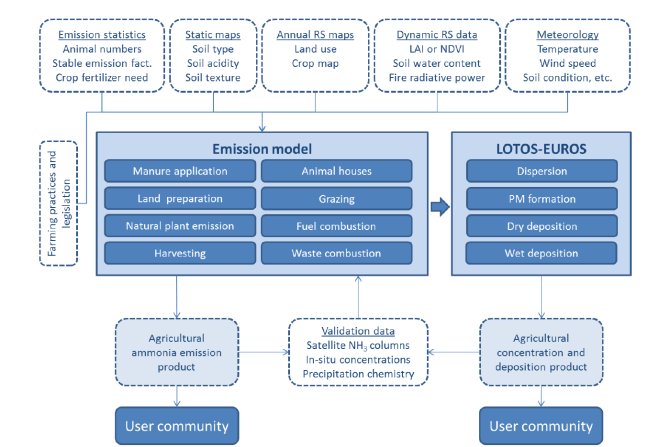Project
Ammonia emissions from agriculture optimized by earth observations (AMARETTO)
Emissions of ammonia to air from the agricultural sector have large negative societal impacts. Ammonia contributes to eutrophication and acidification of terrestrial and marine ecosystems and loss of biodiversity. Despite its central role in many environmental threats, the uncertainty in agricultural ammonia emissions is large.
This project aims to improve the quantification of agricultural ammonia emissions at European scale using earth observation and meteorological data which will increase insight in the temporal dynamics of agricultural practices and emissions over the year. The contribution of the agricultural sector to nitrogen deposition in Europe will thus be quantified, being a crucial product in view of biodiversity impacts.
Aim of the project
The overall objective of AMARETTO is to quantify the impact of agriculture on loads of ammonia at European scale based on the optimization of a dynamic agricultural emission model within LOTOS-EUROS through earth observation products. Specific objectives of AMARETTO are to:
- Improve the understanding of processes and mechanisms that induce the variability in ammonia emissions, concentrations and deposition;
- Develop methodologies and parameterizations to detail agricultural emissions with remote sensed information on practices, vegetation growth, surface conditions and atmospheric concentrations;
- Provide novel ecosystem specific nitrogen deposition distributions based on detailed ammonia emissions and assimilation of satellite data.

Method
The quantification of agricultural ammonia emissions at European scale will be improved using earth observation and meteorological data which will increase insight in the temporal dynamics of agricultural practices and emissions over the year. The atmospheric ammonia budget will be modelled using LOTOS-EUROS. The novel emission product will be verified using ammonia column data from IASI and CrIS and in-situ observations. Finally, ammonia emission strengths will be inverted from the IASI data with LOTOS-EUROS. More in detail, the activities are:
Improvement of spatial and temporal allocation based on available models
- Inclusion of spatial allocation with INTEGRATOR
- Inclusion of time dependent housing and application emissions: agricultural activity timer
Improvement of spatial and temporal allocation in available emission models
- Improvement of the spatial allocation of farming practices
- Improvement of the temporal allocation in farming practices
- Evaluation of emission variability over the Netherlands and the Po-Valley
- Assessing an improved European ammonia budget
- Predict ammonia emissions in response to improved agricultural practices and changing climate